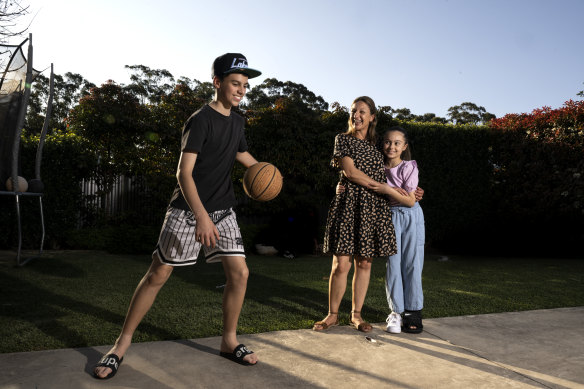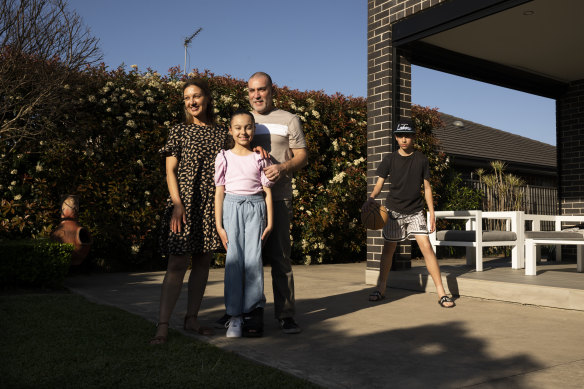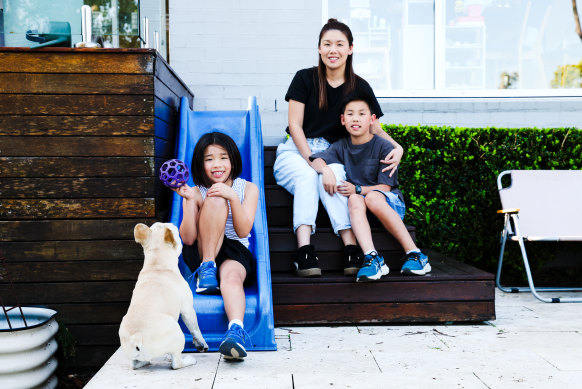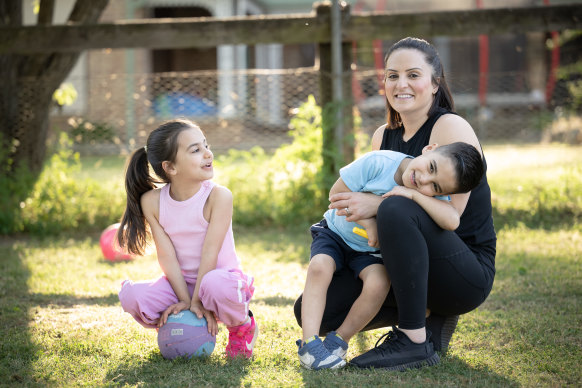By Lucy Carroll and Nigel Gladstone
The state’s public primary schools enrolled 21,600 fewer students last year compared with 2019, while private schools lifted their share of pupils in the bulk of Sydney’s local government areas.
A Herald analysis of new data shows private primary school enrolments have soared in the north and south-west fringes as the public system has struggled to meet demand driven by an influx of families to outer suburbs.

Christine Oliveri, here with children Valentino and Ellaria, moved to Harrington Park in Sydney’s south-west a decade ago.Credit: Louise Kennerley
The vast majority of NSW’s primary-aged students attend public schools. But over the past five years the proportion of children attending public primary schools slipped to 68 per cent, its lowest since 2006.
An exodus of young families from Sydney, migration changes and more parents enrolling children in low-fee private schools in growth areas are some factors behind the enrolment drop, experts say.
Public education is strongest in Willoughby, Wollondilly, Parramatta and Campbelltown LGAs where about 78 per cent of children are in government primary schools.
It’s lowest in Woollahra, Randwick and Burwood, where more than half of primary-aged students attend private or Catholic schools.
Despite fee hikes – year 6 has tipped past $35,000 at some schools – and the cost-of-living crunch, private primary school enrolments increased in more than 20 local government areas over five years.
In the Camden LGA, student numbers in all sectors climbed as parents flocked to south-western greenfield development areas. Private primary schools lifted enrolments in that area by 59 per cent over five years, compared with 24 per cent in public.
“We were here before other schools. And the developer was keen on an independent school in the centre of Oran Park,” said Naomi Wilkins, principal of K-12 school Oran Park Anglican College.
“A wave of families moved into the area. Often both parents are working and they choose us for our values, location, the care of students and Christian focus.” The south-west school, which has added 1000 students in the decade since opening, charges $8300 a year and plans to lift its enrolment cap by 150.
Oran Park Public opened about 10 years ago and rapidly exceeded 1200 students, while the area had no public high school until 2020.
Demographer and social researcher Mark McCrindle said factors including migration and population changes had resulted in the changing enrolment picture.
“Overseas migration fell during the pandemic, so the public system didn’t get that bolster it normally would,” McCrindle said. “NSW is also losing more people than it is gaining. There is movement to south Queensland and the main reason is housing and cost-of-living pressures. It may be those shifts are affecting the public system more.”
A Productivity Commission report warned this year the city’s rental prices had led to an exodus of people aged 30 to 40, many relocating to regional areas or interstate.
McCrindle said young families are increasingly relocating to housing developments in the city’s growth areas. “They tend to be aspirational and looking for schools that align with that. Low-fee private schools can offer an alternative,” he said.

Christine and Ross Oliveri with Ellaria and Valentino, who attend Oran Park Anglican College, at their Harrington Park home.Credit: Louise Kennerley
Christine Oliveri and her family moved from Green Valley near Liverpool to Harrington Park in the south-west a decade ago. “Before we bought land here I looked around at the schools. My son started at Oran Park Anglican in prep and the school goes through to year 12, so there is no need to change in high school,” she said. “I like the school’s values, and the community. You don’t feel like an outsider.”
Planning adviser Stephen Earp, who has worked on more than 350 schools across all sectors, said private schools can often react quickly to demand by taking up opportunities when land comes onto the market, and can start smaller campuses.
“This has been brewing for a while. In the city’s outer suburbs in the south-west, and Gables and Box Hill in the north-west, the residential boom has outstripped demand for schools,” he said.
‘I wanted my kids to walk to school’
Bernadette Wang lives in the Willoughby LGA, where about 80 per cent of students attend public primary schools. She enrolled her two children at Mowbray Public in Lane Cove, which has doubled its enrolments to 730 in the past decade.

Bernadette Wang with her children Abby and Ashton, who attend their local public school in Lane Cove.Credit: Edwina Pickles
“I wanted my kids to walk to their local public school,” she said. “I also like the school’s diversity. My kids have had great teachers, which is why I wanted to stay even though we moved just outside the catchment zone.”
Mowbray Public was rebuilt in 2016 anticipating a flood of families moving into apartment developments in Lane Cove. Principal Caroline Alford said extracurricular activities such as band and choir, plus low teacher turnover, created a positive school culture.
“Staff are dedicated to the whole child, both in academics and giving them extra opportunities,” said Alford.
‘I can be at my desk by 8’
The strongest local government areas for Catholic primary school enrolments are Canada Bay, Bayside, Hunters Hill and Randwick. There, about one in three students attend a Catholic school.
In the past five years Catholic primary enrolments have clocked up the fastest growth in the Hills Shire LGA – jumping 25 per cent.
Mother-of-three Maria Abraham chose Santa Sophia Catholic College in Box Hill after moving to Maraylya from Concord. The convenience of the school’s hours was a major drawcard. “I drop off at 7.40, and I can be at my desk by about 8,” she said.

Maria Abraham with two of her children, Scarlett and Levi. The family relocated from Concord to Maraylya in the north-west.Credit: Wolter Peeters
“Box Hill is so much more affordable. We also knew we’d absorb the school fees along the way. The faith aspect was a big reason for our school choice and how we want a school to shape our kids.”
Poor public school planning had plagued parts of the north-west, with parents frustrated at lagging infrastructure. It is an issue the government says it is rectifying.
Some public schools have swelled. Northbourne Public in Marsden Park has 2000 students, hundreds over its cap, and has 40 demountables. At the same time more non-government schools have opened in the north-west, including St Luke’s Catholic College, which has a school day that runs from early morning until the evening to suit parents with long commutes.
‘Sydney has changed dramatically’
A NSW Education Department spokesperson said the government is taking a “proactive approach” to support the north-west, including opening three schools as an “urgent stop-gap”. New and upgraded schools are also planned for Box Hill, Gables and Schofields.
Catholic Schools NSW chief executive Dallas McInerney said his sector’s schools were enrolling more students and it was “important to meet demands as residential and societal trends evolve and respond with new and upgraded schools. Sydney has changed dramatically and all sectors needed to respond.”
In 2023 NSW public primary schools enrolled about 68 per cent of students, while independent and Catholic schools enrolled about 14 per cent and 18 per cent. Five years ago public primary schools enrolled about 70 per cent of students. NSW public schools educate 62.9 per cent of students across both primary and high schools.
In the past five years private primary schools added 10,889 students, and Catholic schools about 3000, while public school enrolments fell by 21,638. Preliminary data for this year shows public school enrolments have fallen about 24,000 since 2019.
In the eastern suburbs and inner-west primary schools declines have occurred in the three school sectors.
Paddington Public has 45 per cent fewer enrolments than 2019, Bondi Beach Public is down 37 per cent, Coogee Public is down by a third and Birchgrove Public has 23 per cent fewer students.
Macquarie University demographer Nick Parr said in contrast to a declining fertility rate nationally, outer suburbs have rising fertility rates.
“In rapidly growing suburbs the proportions of couples who were both in employment has increased. It could mean couples with a double income are more able to afford private school fees.”
A department spokesperson said the falling enrolments were being addressed. “A lack of public school infrastructure in high-growth areas has impacted the ability of families to enrol in public schools and we are working to turn this around, including investing $3.6 billion for new and upgraded schools in western Sydney,” the spokesperson said.
A separate snapshot has shown a growing number of students in religious schools, underpinned by rising enrolments in Islamic and Christian schools. Principals have previously said parents are attracted to private schools due to the perception they offer more disciplined environments.
Association of Independent Schools of NSW chief executive Margery Evans said growth in the independent sector “reflects a long-term trend of more families from across the socioeconomic spectrum choosing a school for their child that reflects their beliefs, cultures and objectives”.
Data has shown Australian students perform no better academically if they attend a private school over a public school once socioeconomic background is considered.
Former NSW education minister Adrian Piccoli said “non-stop publicity” about teacher shortages during the pandemic and throughout the wages campaign was damaging for public education. “The public system provides very high-quality education, but significant negative publicity can have an impact on parents’ perception,” he said.
NSW Teachers Federation president Henry Rajendra said: “Public school teachers do amazing things for their students every day, against the odds of under-resourcing and crushing workloads. Imagine the possibilities if they were properly resourced, as governments of all political stripes have promised for more than a decade.”
Start the day with a summary of the day’s most important and interesting stories, analysis and insights. Sign up for our Morning Edition newsletter.